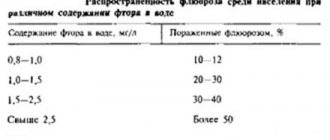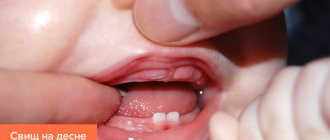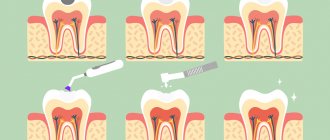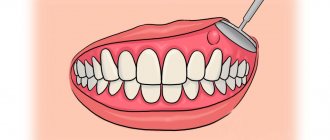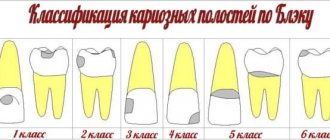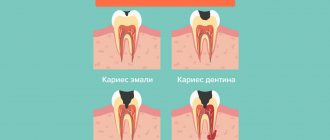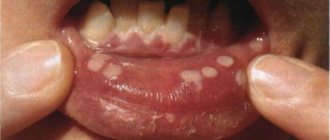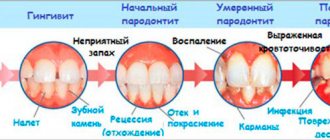Author of the article:
Soldatova Lyudmila Nikolaevna
Candidate of Medical Sciences, Professor of the Department of Clinical Dentistry of the St. Petersburg Medical and Social Institute, Chief Physician of the Alfa-Dent Dental Clinic, St. Petersburg
Pulpitis is an inflammatory lesion of the dental nerve (pulp), which is usually accompanied by severe pain. Its prevention is compliance with the rules of oral hygiene.
We recommend using Asepta toothpastes and rinses. They effectively clean teeth, reduce the number of pathogenic bacteria in the oral cavity, and prevent caries.
Symptoms of pulpitis
The main symptom of this inflammatory disease is severe pain. It begins in the oral cavity, then spreads further and “gives” to the head, ear or neck. As a rule, it occurs spontaneously; quite often it can occur at night. Taking painkillers only brings temporary relief, then the pain returns again.
It is important not to start the process and contact your dentist on time; delay can be fraught with various complications. For example, periodontitis, gumboil, phlegmon and subsequently forced tooth extraction.
What is pulpitis and why does it develop?
In dentistry, pulpitis is an inflammation of the central part of the tooth - the pulp, which provides a neurovascular bundle. Located deep in the dental tissue, under the enamel and dentin. The disease is more often of a bacterial nature and develops against the background of caries or tooth trauma; less often, infection occurs through the bloodstream. The pulp contains many vessels and nerves and provides the tooth with sensitivity. It is where dentin is formed, which is responsible for hard dental tissue. Different types of teeth have their own pulp structure. In the molars, there are three canals, and in the anterior ones there are incisors, premolars or canines, just one canal each. The more canals a tooth contains, the more difficult the treatment is. In the International Classification of Diseases (ICD - 10), pulpitis is coded K04 - “Diseases of the pulp and periapical tissues.” During the development of pulpitis, deep tissue inflammation, swelling, and damage to nerve endings occur, which causes severe pain. More often, the disease develops due to poor dental care and carious lesions. The culprit of the inflammatory reaction is considered to be bacteria that have penetrated into the deep tissues of the tooth. In addition to caries, the development of pulpitis can be triggered by:
- tooth injury;
- deposits of mineral substances inside the pulp;
- consequences of improper dental treatment.
The last type of pulpitis can manifest itself as a complication after a visit to the dentist, be the result of the use of low-quality filling material, or develop after opening the internal cavity of the tooth. The triggering factor for the development of pulpitis may be improper oral care, diabetes mellitus or osteoporosis.
Pulpitis is characterized by acute dental pain, often throbbing. It can be stopped with analgesics, but in this way a person loses precious time, since the inflammation will spread to the tooth root, which will lead to tooth loss or purulent inflammation, and the development of gumboil.
Biological method of treating pulpitis
Although the biological method is more humane, unfortunately, it cannot always be used. To do this, several conditions must be met:
- the patient should consult a doctor no later than a day or two after the first pain symptoms appear;
- The patient's caries should be of low intensity;
- somatic diseases and allergic reactions should be absent;
- the pulp was exposed accidentally.
Biological treatment of pulpitis is impossible if the patient has chronic diseases of the oral cavity or there is carious damage to the root or neck of the tooth.
The effectiveness of treatment for this inflammatory disease depends on how far the infection has spread and where it is located.
Why is it important to preserve the nerve of the tooth?
The vitality of the tooth is ensured by the vessels and nerve endings that are located inside the dentin. Due to this, hard tissues receive nutrition, like other human organs. Without pulp, the tooth becomes dead. It darkens and becomes ugly. If it is in the smile area, a serious aesthetic defect occurs. In addition, without a nerve, the tooth is more vulnerable to external factors. It is much more likely to break or crack. Using a biological method, pulp removal can be prevented and the full functionality of the tooth can be maintained.
Algorithm for treating pulpitis using a biological method
To treat inflammatory lesions of the pulp using a biological method, one or two visits to a specialist dentist will most often be required. In the first case, the tooth will be immediately filled, and in the second, the doctor will first put a temporary filling, putting anti-inflammatory and antibacterial drugs into the tooth, then schedule a second visit, during which he will replace the temporary filling with a permanent one.
The treatment algorithm for pulpitis is usually as follows:
- Anesthesia is performed.
- The doctor removes the affected areas and cleans the carious cavity.
- The cavity is treated with an ionizer or a special antiseptic.
- The carious cavity is thoroughly dried with warm air.
- A special gasket is placed at the bottom of the cavity. Most often it is impregnated with calcium-containing and antibacterial substances.
- A temporary or permanent filling is installed.
As a rule, the temporary filling is replaced with a permanent one after a couple of weeks, provided that the patient does not complain of pain. If he experiences pain, he may have to change the medicine, and in an emergency, even resort to surgical treatment.
Also, a month or two after treatment, the dentist may order an x-ray of the tooth to make sure that the treatment was carried out correctly.
It is worth recognizing that not all dentists prefer the biological method of treatment, since it is associated with a high risk of possible reappearance of pulpitis.
Modern approach
Nowadays, the treatment of mental disorders follows the rules of complex therapy, focusing on syndromic manifestations, taking into account the duration and progression of the process. Each case requires an individual approach, taking into account the characteristics of the patient and his environment, and the sequence of application of methods.
Despite the fact that methods for relieving such disorders have made great progress, there are still some problems in their implementation. First of all, this is due to the fact that it is still not possible to establish the causes of many mental illnesses. Secondly, today psychogenic diseases are tirelessly progressing, acquiring new forms.
Since the human brain and psyche are the least studied areas, they present many “surprises”. And you can never be sure that the disease will go away forever.
Conventionally, the principles of treatment of mental disorders can be divided into biological therapy and psychotherapy .
Biological therapy combines methods that address the biological causes of the disorder. The most famous of them:
- pharmacotherapy;
- efferent therapy;
- electroconvulsive;
- insulin shock;
- narcopsychotherapy.
Pharmacotherapy
This method is the basis for the relief of mental disorders. Its functions are:
- elimination of the acute period of the disease in a hospital setting until remission occurs;
- stable use of medications as relapse prevention in a hospital or outpatient setting;
- maintenance therapy to achieve stable remission.
Taking medications can eliminate pathological symptoms and stop the progression of the process.
Among psychotropic drugs , there are several classes that affect a specific group of symptoms:
- antidepressants;
- tranquilizers;
- neuroleptics;
- mood stabilizers;
- nootropics;
- psychostimulants.
Antidepressants act on depressive symptoms; such drugs include both stimulants and sedatives. On the one hand, they stimulate a person to activity, eliminate apathy, lack of will, gloomy thoughts and a decadent mood, and on the other hand, they relieve anxiety and calm. Representatives:
- amitriptyline;
- Prozac;
- Azafen.
There are several generations of antidepressants, each subsequent of which is more effective and less traumatic.
Tranquilizers perform 5 main actions: relieve anxiety, calm, normalize sleep, promote muscle relaxation and exhibit an anticonvulsant effect. But not all products in this group have all of the listed properties. Each class of tranquilizers “specializes” more in several of them. In addition, there are those that exhibit an activating effect. Indications for use are neuroses and various types of anxiety disorders. Representatives:
- Tofisopam;
- Seduxen.
Neuroleptics are prescribed when psychopositive symptoms appear in the clinical picture of the disease: delusions, hallucinations, mania, distortions of behavior and thinking, aggression. Indicated for psychosis. Representatives:
- Risperidone;
- Amisulpride;
- Haloperidol.
Normotimics. Drugs in this group normalize mood and prevent its polar fluctuations. Accordingly, manic-depressive psychosis becomes a direct indication for their use. These include:
- lithium preparations;
- Depakine;
- Lamotrigine.
Nootropics improve the metabolism of brain tissue and restore cognitive function. Therefore, they are widely used for mental disorders accompanied by changes in cerebral circulation, atherosclerosis of cerebral vessels: dementia, neuroses, alcoholism, vegetative-vascular dystonia, etc. Representatives:
- Piracetam;
- Phenibut;
- Nootropil.
Psychostimulants activate mental activity and increase motor activity. Relieves lethargy and fatigue. Indications: apathy, asthenia. Representatives:
- Sidnocarb;
- Caffeine.
Psychotropic drugs are prescribed exclusively by a doctor and require careful dosage adjustment. Some of their effects become a big problem on the path to healing.
Many such drugs have a list of side effects that are difficult for patients to tolerate. Scientists are trying to improve their formulas, developing new generations of drugs that are more advanced and gentle in their action.
Another problem is the development of dependence or, conversely, resistance to their effects. In addition, they require long-term use, and sometimes it is difficult to choose the appropriate remedy and dosage.
All these nuances lead to the fact that patients often refuse to undergo treatment, abandoning it halfway. This becomes a huge step backward and negates the positive results achieved.
Efferent therapy
This method of biological therapy involves purifying the blood and improving its parameters. Its methods include:
- Plasmapheresis is taking blood from a patient and dividing it into plasma and blood cells. The cells are subsequently returned to the patient and the plasma is replaced by intravenous solutions.
- Cryoplasmapheresis - plasma is detoxified and returned to the patient.
- Hemosorption, plasma sorption - plasma or blood is passed through sorbents;
- Hemofiltration is the purification of blood in a special filter.
- Thermofiltration - enhancing hemofiltration properties by heating.
- Hemodialysis or an artificial kidney machine is used to remove toxins from the blood if the patient's kidneys do not work on their own.
- Ultraviolet irradiation of blood.
- Laser irradiation of blood.
The methods listed above have a detoxifying, regenerating and immunostimulating effect on the body. As a result, during the treatment of mental disorders it is possible to achieve antidepressant, antipsychotic and psychostimulating effects.
This procedure is indicated for particularly toxic disease. For example, this applies to febrile schizophrenia, a form of disorder accompanied, in addition to the main symptoms, by oneiroid-type changes in consciousness and autonomic disorders. Its main symptom is fever. Moreover, it does not fall under the typical temperature curve characteristic of somatic diseases. The appearance of bruises and the development of cachexia, that is, exhaustion, are possible. Delusions and hallucinations during this period reach their peak and are malignant. Catalepsy is observed - the so-called waxy flexibility, when the patient takes on any shape given to him.
Other conditions requiring efferent intervention include:
- poisoning with narcotic and pharmaceutical drugs, poisons;
- delirium of various origins;
- hallucinatory syndromes that cannot be controlled with medication.
Other biological therapies
These include shock treatment methods: insulin comatose and electroconvulsive therapy.
Shock insulin therapy is, as already mentioned, the administration of increased doses of insulin. They are increased gradually, bringing the patient first to hypoglycemia and then to coma. The course includes up to 30 procedures.
The patient is brought out of coma by administering glucose solutions. The method involves stimulating the body's adaptive mechanisms under shock conditions, so that it can resist the disease.
This method is contraindicated for infectious diseases, liver and kidney failure, endocrine pathologies, as well as during pregnancy, heart pathologies and cancer.
Electroconvulsive therapy is used extremely rarely in cases where drug treatment does not bring results. It is usually used for patients with febrile schizophrenia and severe depression. Previously, the patient undergoes a thorough examination.
The method involves exposing the patient to an electric current discharge, causing convulsions. It is assumed that in this way the subcortical centers of the brain are stimulated. It is allowed to use up to 10 sessions of such therapy.
Surgical methods of treating mental disorders are resorted to in cases when all other methods of therapy become ineffective. The duration of the process (5 years or more) and the patient’s disability are also used as arguments. The main criterion for surgical intervention is the presence of a structural target, that is, an established organic cause of the disease.
Clinical researches
ASEPTA products have clinically proven effectiveness.
- Repeated clinical studies have proven that using ASEPTA propolis gum gel for a week can reduce gum inflammation by 31%.
- Repeated clinical studies of the ASEPTA ACTIVE mouth rinse have proven that this two-component product effectively combats the causes of inflammation and bleeding in the mouth - it reduces inflammation by 41% and reduces bleeding gums by 43%.
- It has been clinically proven that regular use of ASEPTA SENSITIVE toothpaste for a month can reduce bleeding gums by 62%, reduce tooth and gum sensitivity by 48% and reduce inflammation by 66%.
According to the results of clinical use of the Asepta series of products: in the majority of patients examined, the level of hygiene according to Green-Vermillion was satisfactory.
Already at the first follow-up examination (1-2 days) after using the Asepta line products, a decrease in complaints of discomfort is noted. On the 7th day, complaints of gum bleeding persisted in a small proportion of patients, but upon examination, all of them noted a decrease in hyperemia and swelling of the gums, but persistence of bleeding upon probing. On day 14, 2 patients continued to complain of bleeding gums when brushing their teeth; upon examination, a significant decrease in hyperemia and swelling of the gums was noted.
Improved dynamics of indicators allows us to recommend the Asepta line of products for the local treatment of inflammatory periodontal diseases.
Sources:
- The effectiveness of the use of Asept “adhesive balm” and Asept “gel with propolis” in the treatment of chronic generalized periodontitis and gingivitis in the acute stage (Municipal Dental Clinic No. 4, Bryansk, Kaminskaya T. M. Head of the therapeutic department Kaminskaya Tatyana Mikhailovna MUZ City Dental Clinic No. 4, Bryansk
- The role of anti-inflammatory rinse in the treatment of periodontal diseases (L.Yu. Orekhova, A.A. Leontyev, S.B. Ulitovsky) L.Yu. OREKHOVA, Doctor of Medical Sciences, Prof., Head of Department; A.A. LEONTIEV, dentist; S.B. ULITOVSKY, Doctor of Medical Sciences, Prof. Department of Therapeutic Dentistry of St. Petersburg State Medical University named after. acad. I. P. Pavlova
- Clinical studies of antisensitive toothpaste “Asepta Sensitive” (A.A. Leontyev, O.V. Kalinina, S.B. Ulitovsky) A.A. LEONTIEV, dentist O.V. KALININA, dentist S.B. ULITOVSKY, Doctor of Medical Sciences, Prof. Department of Therapeutic Dentistry, St. Petersburg State Medical University named after. acad. I.P. Pavlova
- Clinical experience in using the Asepta series of products Fuchs Elena Ivanovna Assistant of the Department of Therapeutic and Pediatric Dentistry State Budgetary Educational Institution of Higher Professional Education Ryazan State Medical University named after Academician I.P. Pavlova of the Ministry of Health and Social Development of the Russian Federation (GBOU VPO RyazSMU Ministry of Health and Social Development of Russia)
Our team of doctors
Maxillofacial surgeon, Implantologist
Bocharov Maxim Viktorovich
Experience: 11 years
Orthopedist, Neuromuscular dentist
Stepanov Andrey Vasilievich
Experience: 22 years
Endodontist, Therapist
Skalet Yana Alexandrovna
Experience: 22 years
Orthopedic dentist
Tsoi Sergey Konstantinovich
Experience: 19 years
Endodontist, Therapist, Orthopedist
Varvyanskaya Anastasia Andreevna
Experience: 6 years
Dentist-orthodontist
Enikeeva Anna Stanislavovna
Experience: 3 years
Chronic form of pulpitis
This form of pathology is almost impossible to eliminate using conservative methods. Most often in this situation, the neurovascular bundle is removed. This is due to the presence of irreversible processes in the pulp. The pathology develops over a long period of time, against the background of massive carious lesions. Also, the transition to chronic tooth pulpitis and the need for its treatment can be provoked by the patient himself, if the trip to a specialist is delayed.
Characteristic signs of chronic pulpitis are:
- The pain is aching, dull in nature. It appears in the presence of thermal or chemical irritants, and may disappear under the influence of cold;
- Pain occurs when chewing food or pressing on a tooth;
- Periodically, periods of exacerbation make themselves felt, the symptoms of which resemble an acute form of the pathology.
It should be noted that types of chronic disease can still be eliminated without depulpation. Below we will provide a table that will help you decide on the appropriate treatment method. For example, if the signs of the disease are sluggish, but carious areas are present, then we can assume that you have chronic fibrous pulpitis and select the appropriate treatment.
| Variety | Characteristic | Is it possible to preserve the pulp? |
| Gangrenous | Under the influence of infection, complete death of the nerve occurs, which is accompanied by inflammatory processes. | – |
| Focal | Only the portion of the neurovascular bundle is subject to the inflammatory process. | Partial |
| Diffuse | Pathological processes affect both the root and crown of the tooth. | – |
| Fibrous | The signs resemble a complication of a deep carious process. Symptoms are mild or completely absent. | + |
| Hypertrophic | They are characterized by active growth of the nerve and the presence of bleeding. | – |
How is the treatment carried out?
First visit:
- The doctor performs anesthesia. Thanks to painkillers, all manipulations performed by the dentist will be comfortable for the patient. Mandibular anesthesia is sometimes required for mandibular molars.
- Carious and partially healthy dental tissues are drilled out. The latter are used to open the mouth of the root canal and provide access to them for working with instruments.
- A rubber dam is placed to protect the canals from saliva, which may contain pathological microflora.
- A pulp extractor (a very thin barbed needle) is used to remove the nerve.
- A special devitalizing paste without arsenic is applied to the treatment site (it is not used in modern products due to toxicity).
- The doctor determines the length of the root canal using radiography with an apex locator. In cases where there are several canals, a K-file is inserted into them one by one, which, when penetrating deeper, indicates that the instrument has reached the apex of the tooth root. This is done with each channel separately, since their depth is not the same.
- The canals are widened for subsequent filling. At the same time, washing with antiseptic agents is carried out constantly.
- Placement of turundas into the canals and installation of a temporary filling.
Second visit:
- The doctor removes the temporary filling.
- The canal is washed with antiseptics and then dried.
- The canal is sealed. To do this, the dentist uses a gutta-percha point and paste. The pin is used to compact the filling compound.
- Finally, you need to take an x-ray to make sure that all actions were performed correctly and that the filling is tight to the top of the canal.
- A temporary filling is placed again. After this, painful sensations may persist for some time. To eliminate them, it is allowed to take ibuprofen, ketanov, nimesil and other drugs that the dentist should recommend.
Third visit:
- A permanent light-polymer filling is placed.

